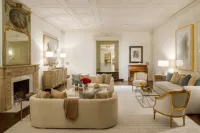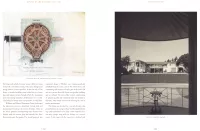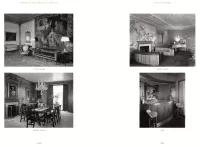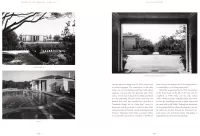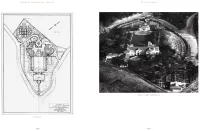Share what you know,
and discover more.
Share what you know,
and discover more.
Sep 14, 2022
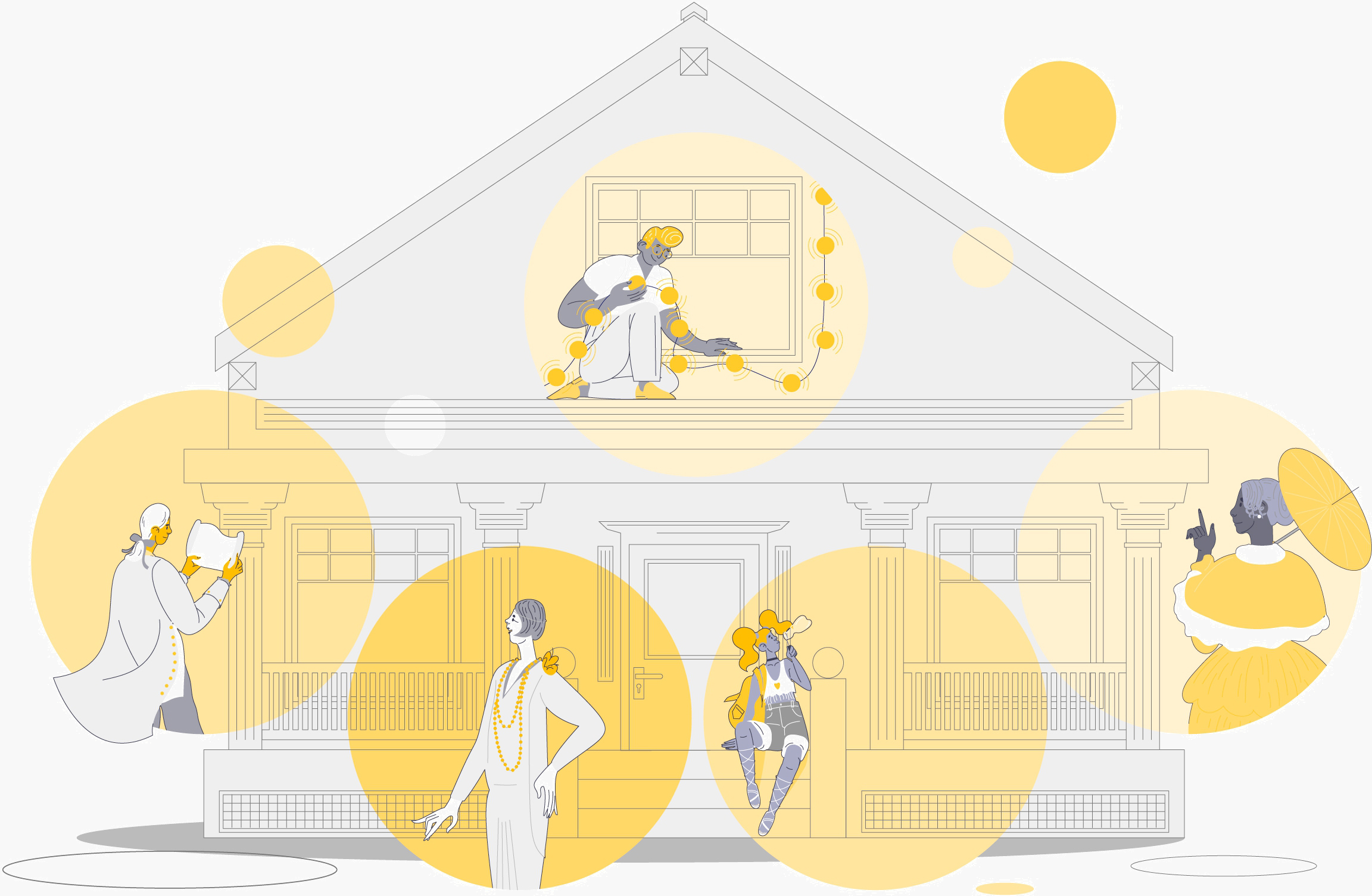
-

- Charmaine Bantugan
Jay Paley House
The Jay Paley House is a large house at 1060 Brooklawn Drive, near the borders of Benedict Canyon, Holmby Hills, Bel Air, and Beverly Hills in Los Angeles. It was designed by Paul R. Williams for businessman Jacob Jay Paley (1885-1960) and his wife Lilian (1893-1954). The 13 bedroom, 15,100 sqft house was built in 1935 on a six-acre estate. Background Jay Paley and his brother Samuel were Russian immigrants who had founded the Congress Cigar Company, manufacturers of the La Palina brand, in Chicago in the 1890s. The Paley family founded the Columbia Broacasting System (CBS), and Paley subsequently sold a substantial shareholding in 1928 for several million dollars. He became a film producer in the early 1930s, and in 1934 founded JayPay Productions with film executive Walter Wanger in association with Paramount Studios in 1934. He sold further CBS shares to Samuel Paley, his brother, and his nephew William S. Paley to finance his film production company. Paley and his wife Lilian moved to Los Angeles, and the house was commissioned. Williams had previously designed a house for Jay Paley's nephew, William S. Paley, at 200 South Mapleton Drive that was completed in 1934. Paley subsequently invested in the Arrowhead Springs Hotel, which was also designed by Williams. Hilton ownership After Paley's death in 1961, the furnishings were sold at auction and the estate subdivided and developed. The house, retaining the pool & tennis court, sold for $475,000 (equivalent to $4,307,266 in 2021) to Barron Hilton. The businessman and hotelier lived at the house until his death in 2019. The Hilton family sold the estate in May 2021 to former google CEO Eric Schmidt for $61.5 million. Design The two storey brick house is designed as a modified H-plan, made up of 32 rooms. The northwest and southwest wings and center are extended to form an E-configuration from the flat facade. The entrance door is framed with wooden columns and a pediment. The rear of the house also has extended northeast and southwest wings, with a two-storey conical roof supported by columns summouting the semicircular southeast wing. A central hall runs the entire length of the house from north to south. A large living room is to the right, it opens to a small garden and ornamental pond. The first floor is the site of the music room and the library. The east side of the house contains the dining room, a breakfast room, and four maids rooms with a separate living room. A private garden for the servants is located next to the service wing. Writing in The Legendary Estates of Beverly Hills, Jeffrey Hyland felt that the house marked a 'new direction' for Williams as "He started with the traditional English Georgian style and then gave the residence a thoroughly modernist spirit, creating a residence that was both traditional and contemporary". The style of the house has also been described as Hollywood Regency and English Georgian. The house was built by the building contractors O'Neal and Sons, at a cost of $100,000 (equivalent to $1,976,456 in 2021). Interiors The interior of the house was designed by Harriet R. Shellenberger, her interior designs were removed in 1961 following Paley's death. The interior was redesigned by Kathryn Crawford in the 1960s; Crawford's designs for the house were featured in Architectural Digest in September 1968, including gold bathroom faucets across its 13 bathrooms. After redecorating, Hilton displayed his collection of guns and model airplanes. The house also has an 80-seat movie screening room and an elevator. Pool The swimming pool and the pool house precede the main house and were designed by Williams to a Classical design with landscape architect c.1932 and built by the Paddock Pool Complex. The pool house contains a bar and grill and games room. The success of the swimming complex convinced Paley to commission the main house from Williams. The pool is known as the Zodiac pool as the base features the 12 signs of the Zodiac in blue, yellow and gold tiles imported from France with a sunburst design. The pool house was featured on the cover of Architectural Digest in 1933. Owner Jay & Lilian Paley (construction-1961), Barron & Marilyn Hilton (1961-2019), Hilton Family(2019-2021), Eric Schmidt (2021- present) Architect Paul R. Williams
Jay Paley House
The Jay Paley House is a large house at 1060 Brooklawn Drive, near the borders of Benedict Canyon, Holmby Hills, Bel Air, and Beverly Hills in Los Angeles. It was designed by Paul R. Williams for businessman Jacob Jay Paley (1885-1960) and his wife Lilian (1893-1954). The 13 bedroom, 15,100 sqft house was built in 1935 on a six-acre estate. Background Jay Paley and his brother Samuel were Russian immigrants who had founded the Congress Cigar Company, manufacturers of the La Palina brand, in Chicago in the 1890s. The Paley family founded the Columbia Broacasting System (CBS), and Paley subsequently sold a substantial shareholding in 1928 for several million dollars. He became a film producer in the early 1930s, and in 1934 founded JayPay Productions with film executive Walter Wanger in association with Paramount Studios in 1934. He sold further CBS shares to Samuel Paley, his brother, and his nephew William S. Paley to finance his film production company. Paley and his wife Lilian moved to Los Angeles, and the house was commissioned. Williams had previously designed a house for Jay Paley's nephew, William S. Paley, at 200 South Mapleton Drive that was completed in 1934. Paley subsequently invested in the Arrowhead Springs Hotel, which was also designed by Williams. Hilton ownership After Paley's death in 1961, the furnishings were sold at auction and the estate subdivided and developed. The house, retaining the pool & tennis court, sold for $475,000 (equivalent to $4,307,266 in 2021) to Barron Hilton. The businessman and hotelier lived at the house until his death in 2019. The Hilton family sold the estate in May 2021 to former google CEO Eric Schmidt for $61.5 million. Design The two storey brick house is designed as a modified H-plan, made up of 32 rooms. The northwest and southwest wings and center are extended to form an E-configuration from the flat facade. The entrance door is framed with wooden columns and a pediment. The rear of the house also has extended northeast and southwest wings, with a two-storey conical roof supported by columns summouting the semicircular southeast wing. A central hall runs the entire length of the house from north to south. A large living room is to the right, it opens to a small garden and ornamental pond. The first floor is the site of the music room and the library. The east side of the house contains the dining room, a breakfast room, and four maids rooms with a separate living room. A private garden for the servants is located next to the service wing. Writing in The Legendary Estates of Beverly Hills, Jeffrey Hyland felt that the house marked a 'new direction' for Williams as "He started with the traditional English Georgian style and then gave the residence a thoroughly modernist spirit, creating a residence that was both traditional and contemporary". The style of the house has also been described as Hollywood Regency and English Georgian. The house was built by the building contractors O'Neal and Sons, at a cost of $100,000 (equivalent to $1,976,456 in 2021). Interiors The interior of the house was designed by Harriet R. Shellenberger, her interior designs were removed in 1961 following Paley's death. The interior was redesigned by Kathryn Crawford in the 1960s; Crawford's designs for the house were featured in Architectural Digest in September 1968, including gold bathroom faucets across its 13 bathrooms. After redecorating, Hilton displayed his collection of guns and model airplanes. The house also has an 80-seat movie screening room and an elevator. Pool The swimming pool and the pool house precede the main house and were designed by Williams to a Classical design with landscape architect c.1932 and built by the Paddock Pool Complex. The pool house contains a bar and grill and games room. The success of the swimming complex convinced Paley to commission the main house from Williams. The pool is known as the Zodiac pool as the base features the 12 signs of the Zodiac in blue, yellow and gold tiles imported from France with a sunburst design. The pool house was featured on the cover of Architectural Digest in 1933. Owner Jay & Lilian Paley (construction-1961), Barron & Marilyn Hilton (1961-2019), Hilton Family(2019-2021), Eric Schmidt (2021- present) Architect Paul R. Williams
Sep 14, 2022
Jay Paley House
The Jay Paley House is a large house at 1060 Brooklawn Drive, near the borders of Benedict Canyon, Holmby Hills, Bel Air, and Beverly Hills in Los Angeles. It was designed by Paul R. Williams for businessman Jacob Jay Paley (1885-1960) and his wife Lilian (1893-1954). The 13 bedroom, 15,100 sqft house was built in 1935 on a six-acre estate.Background
Jay Paley and his brother Samuel were Russian immigrants who had founded the Congress Cigar Company, manufacturers of the La Palina brand, in Chicago in the 1890s. The Paley family founded the Columbia Broacasting System (CBS), and Paley subsequently sold a substantial shareholding in 1928 for several million dollars. He became a film producer in the early 1930s, and in 1934 founded JayPay Productions with film executive Walter Wanger in association with Paramount Studios in 1934. He sold further CBS shares to Samuel Paley, his brother, and his nephew William S. Paley to finance his film production company.
Paley and his wife Lilian moved to Los Angeles, and the house was commissioned. Williams had previously designed a house for Jay Paley's nephew, William S. Paley, at 200 South Mapleton Drive that was completed in 1934. Paley subsequently invested in the Arrowhead Springs Hotel, which was also designed by Williams.
Hilton ownership
After Paley's death in 1961, the furnishings were sold at auction and the estate subdivided and developed. The house, retaining the pool & tennis court, sold for $475,000 (equivalent to $4,307,266 in 2021) to Barron Hilton. The businessman and hotelier lived at the house until his death in 2019. The Hilton family sold the estate in May 2021 to former google CEO Eric Schmidt for $61.5 million.
Design
The two storey brick house is designed as a modified H-plan, made up of 32 rooms. The northwest and southwest wings and center are extended to form an E-configuration from the flat facade. The entrance door is framed with wooden columns and a pediment. The rear of the house also has extended northeast and southwest wings, with a two-storey conical roof supported by columns summouting the semicircular southeast wing. A central hall runs the entire length of the house from north to south. A large living room is to the right, it opens to a small garden and ornamental pond. The first floor is the site of the music room and the library. The east side of the house contains the dining room, a breakfast room, and four maids rooms with a separate living room. A private garden for the servants is located next to the service wing.
Writing in The Legendary Estates of Beverly Hills, Jeffrey Hyland felt that the house marked a 'new direction' for Williams as "He started with the traditional English Georgian style and then gave the residence a thoroughly modernist spirit, creating a residence that was both traditional and contemporary". The style of the house has also been described as Hollywood Regency and English Georgian.
The house was built by the building contractors O'Neal and Sons, at a cost of $100,000 (equivalent to $1,976,456 in 2021).
Interiors
The interior of the house was designed by Harriet R. Shellenberger, her interior designs were removed in 1961 following Paley's death. The interior was redesigned by Kathryn Crawford in the 1960s; Crawford's designs for the house were featured in Architectural Digest in September 1968, including gold bathroom faucets across its 13 bathrooms. After redecorating, Hilton displayed his collection of guns and model airplanes. The house also has an 80-seat movie screening room and an elevator.
Pool
The swimming pool and the pool house precede the main house and were designed by Williams to a Classical design with landscape architect c.1932 and built by the Paddock Pool Complex. The pool house contains a bar and grill and games room. The success of the swimming complex convinced Paley to commission the main house from Williams. The pool is known as the Zodiac pool as the base features the 12 signs of the Zodiac in blue, yellow and gold tiles imported from France with a sunburst design. The pool house was featured on the cover of Architectural Digest in 1933.
Owner
Jay & Lilian Paley (construction-1961), Barron & Marilyn Hilton (1961-2019), Hilton Family(2019-2021), Eric Schmidt (2021- present)
Architect
Paul R. Williams
Posted Date
Sep 14, 2022
Historical Record Date
Sep 14, 2022
Source Name
Wikipedia
Source Website
Delete Story
Are you sure you want to delete this story?
Dec 04, 2020
Dec 04, 2020
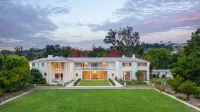
-

- David Decker
The Hilton Family Is Selling the Iconic Jay Paley House for $75 Million
The Hilton Family Is Selling the Iconic Jay Paley House for $75 Million Barron Hilton purchased the estate built by architect Paul R. Williams for about $4 million in the 1960s by Andrea Park, photos: Tyler Hogan / Courtesy of Hilton & Hyland A historic Los Angeles home that has been in the Hilton family for more than half a century is back on the market, with the estate of hotel heir Barron Hilton asking $75 million for the sprawling property, Mansion Global reports. Hilton purchased the home in 1961 and moved in with his family a few years later, once renovations were complete. The house, a Georgian Colonial Revival located in the Holmby Hills neighborhood of L.A., was commissioned from architect Paul R. Williams by businessman Jacob Jay Paley and completed in 1936. Situated on just over 2.5 acres, the two-story mansion is adorned with stately columns and elegant wrought-iron balconies, and spans 15,000 square feet, including 13 bedrooms, 17 bathrooms, a commercial kitchen, and Williams’s trademark circular breakfast room. Hilton purchased the home following Paley’s death for the equivalent of about $4 million in 2020 dollars. He moved in with his wife Marilyn and eight children in the late ’60s, and lived there until his death in September 2019. His son and grandson, Rick and Barron N. Hilton, of the Hilton and Hyland brokerage, are handling the sale. (Yes, they are Paris Hilton’s father and brother.) The “Jay Paley House” is often regarded as the crown jewel in Williams’s impressive portfolio, which also included designs for Lucille Ball and Frank Sinatra. However, any mention of the renowned architect would be remiss not to acknowledge the hypocrisy he faced as a Black man designing glamorous homes in neighborhoods in which his family was then prohibited from residing. “Williams was a genius at architecture—he inspired an entire generation—but he was also a genius at social navigation. One can’t be separated from the other,” LeRonn P. Brooks, an associate curator at the Getty Research Institute, told AD in November.
The Hilton Family Is Selling the Iconic Jay Paley House for $75 Million
The Hilton Family Is Selling the Iconic Jay Paley House for $75 Million Barron Hilton purchased the estate built by architect Paul R. Williams for about $4 million in the 1960s by Andrea Park, photos: Tyler Hogan / Courtesy of Hilton & Hyland A historic Los Angeles home that has been in the Hilton family for more than half a century is back on the market, with the estate of hotel heir Barron Hilton asking $75 million for the sprawling property, Mansion Global reports. Hilton purchased the home in 1961 and moved in with his family a few years later, once renovations were complete. The house, a Georgian Colonial Revival located in the Holmby Hills neighborhood of L.A., was commissioned from architect Paul R. Williams by businessman Jacob Jay Paley and completed in 1936. Situated on just over 2.5 acres, the two-story mansion is adorned with stately columns and elegant wrought-iron balconies, and spans 15,000 square feet, including 13 bedrooms, 17 bathrooms, a commercial kitchen, and Williams’s trademark circular breakfast room. Hilton purchased the home following Paley’s death for the equivalent of about $4 million in 2020 dollars. He moved in with his wife Marilyn and eight children in the late ’60s, and lived there until his death in September 2019. His son and grandson, Rick and Barron N. Hilton, of the Hilton and Hyland brokerage, are handling the sale. (Yes, they are Paris Hilton’s father and brother.) The “Jay Paley House” is often regarded as the crown jewel in Williams’s impressive portfolio, which also included designs for Lucille Ball and Frank Sinatra. However, any mention of the renowned architect would be remiss not to acknowledge the hypocrisy he faced as a Black man designing glamorous homes in neighborhoods in which his family was then prohibited from residing. “Williams was a genius at architecture—he inspired an entire generation—but he was also a genius at social navigation. One can’t be separated from the other,” LeRonn P. Brooks, an associate curator at the Getty Research Institute, told AD in November.
The Hilton Family Is Selling the Iconic Jay Paley House for $75 Million
The Hilton Family Is Selling the Iconic Jay Paley House for $75 MillionBarron Hilton purchased the estate built by architect Paul R. Williams for about $4 million in the 1960s by Andrea Park, photos: Tyler Hogan / Courtesy of Hilton & Hyland
A historic Los Angeles home that has been in the Hilton family for more than half a century is back on the market, with the estate of hotel heir Barron Hilton asking $75 million for the sprawling property, Mansion Global reports. Hilton purchased the home in 1961 and moved in with his family a few years later, once renovations were complete.
The house, a Georgian Colonial Revival located in the Holmby Hills neighborhood of L.A., was commissioned from architect Paul R. Williams by businessman Jacob Jay Paley and completed in 1936. Situated on just over 2.5 acres, the two-story mansion is adorned with stately columns and elegant wrought-iron balconies, and spans 15,000 square feet, including 13 bedrooms, 17 bathrooms, a commercial kitchen, and Williams’s trademark circular breakfast room.
Hilton purchased the home following Paley’s death for the equivalent of about $4 million in 2020 dollars. He moved in with his wife Marilyn and eight children in the late ’60s, and lived there until his death in September 2019. His son and grandson, Rick and Barron N. Hilton, of the Hilton and Hyland brokerage, are handling the sale. (Yes, they are Paris Hilton’s father and brother.)
The “Jay Paley House” is often regarded as the crown jewel in Williams’s impressive portfolio, which also included designs for Lucille Ball and Frank Sinatra. However, any mention of the renowned architect would be remiss not to acknowledge the hypocrisy he faced as a Black man designing glamorous homes in neighborhoods in which his family was then prohibited from residing. “Williams was a genius at architecture—he inspired an entire generation—but he was also a genius at social navigation. One can’t be separated from the other,” LeRonn P. Brooks, an associate curator at the Getty Research Institute, told AD in November.
Posted Date
Sep 14, 2022
Historical Record Date
Dec 04, 2020
Source Name
Architectural Digest
Delete Story
Are you sure you want to delete this story?
Sep 02, 2020
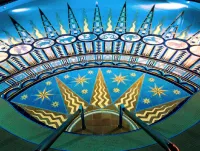
-

- David Decker
Brooklawn Drive - Jay Paley Estate
When Jacob (“Jay”) Paley asked Paul R. Williams to design his house, the forty-year-old architect had reached the top of his profession in California. In the previous decade, Williams had designed important mansions in all of the area’s best neighborhoods: Bel-Air, Beverly Hills, Holmby Hills, Brentwood Park, Hancock Park, Pasadena, and Pacific Palisades. A sophisticated architect who served his clients’ tastes, he designed homes in a rich variety of styles: Spanish, Tudor, Colonial Revival, and French Norman. By the 1930s, he had branched out into commercial work, designing buildings for Saks Fifth Avenue and W. & J. Sloane on Wilshire Boulevard in Beverly Hills. Williams’s residential clients included Hollywood stars Tyrone Power, Barbara Stanwyck, and Frank Sinatra. Some of Williams’s homes were stars in their own right. The Tudor-style sixteen-room Jack Atkin mansion in Pasadena, which Williams designed in 1929, was featured in the classic screwball comedy Topper (1937) starring Cary Grant and Constance Bennett. For automotive pioneer E. L. Cord, Williams designed the almost ten-acre Cordhaven estate (see page 326). The Banning family — raised to wealth and prominence in the 19th century by Phineas Banning, considered the “father of the Port of Los Angeles”—admired Williams so much that they asked him to design three large homes for them in Hancock Park: two next door to each other, and one across the street. One of the most remarkable aspects of Williams’s career was that this brilliant and much sought after architect achieved such success as an African American, despite rampant racism throughout the United States. Paul Revere Williams was born in 1894 in Los Angeles, orphaned at age four, and raised by a kind and intelligent foster mother. At Los Angeles’s Polytechnic High School, he displayed great skill in drawing and enrolled in architectural classes. Young Williams told his instructor that he wanted to become an architect. “He stared at me with as much astonishment as he would have had I proposed a rocket flight to Mars. Who ever heard of a Negro being an architect?” recalled Williams. Fortunately, Williams was as determined and ambitious as he was talented. He attended the Beaux Art Institute of Design and won the school’s prestigious Beaux Arts Medal. At age twenty, he won first prize—and $200—for the design of a community center in Pasadena. Established firms soon recognized Williams’s skills. He worked for town planner and landscape architect Wilbur D. Cook, who had prepared the 1906 master plan for Beverly Hills. He got a job with Reginald Johnson, who worked primarily in Pasadena and Santa Barbara. Finally, he was employed by John C. Austin, which gave him experience working on large, complex commercial structures such as the Shrine Civic Auditorium in Los Angeles. All the while, Williams continued to enter—and win—architectural competitions for small homes. Williams, of course, wanted to have his own practice. In 1921, at the age of twenty-seven, he finally got his big break. Rich and socially prominent Louis Cass, one of Williams’ classmates at Polytechnic High School, asked him to design his new $90,000 mansion in Flintridge. “Let this be a starter for your new office,” Cass told Williams, and that’s what Williams did. He opened his own practice in a small office in downtown Los Angeles’ Stock Exchange Building. When Louis Cass’ equally rich and socially prominent friends visited his new Flintridge home, they admired Williams’ work and hired him to design their own residences. Williams’ career took off in the midst of the 1920s Southern California boom. By the time the Depression hit in 1929, he was a much-admired and well-established architect with a very wealthy clientele that still had money to spend. Ironically, Williams could not have lived in most of the neighborhoods for which he designed homes because restrictive covenants, written by the original landowners, forbade the sale of property to anyone of “African or Ethiopian descent.” Williams succeeded not simply because he was a brilliant architect but because he understood the racism of his day and adapted his working style to mitigate any client prejudice. For example, he learned how to draft plans upside down so that his clients—particularly their wives—could view sample plans without sitting beside him. Clients sat on one side of his desk or worktable, and Williams sat on the other as he sketched upside down. “Naturally, I encountered many discouragements and rebuffs, most of which were predicated upon my color,” Williams said. “I survived a few financial hardships which might have been avoided had my face been white. But I do not regret those difficulties, for I think that I am a far better craftsman today than I would be had my course been free.” Certainly, Williams’ reputation helped him get the commission for the Jay Paley residence, but he also had an “inside track.” He had completed a mansion at 200 South Mapleton Drive for William S. Paley, Jay’s nephew, the previous year. The 1935 commission for the Jay Paley estate was a milestone in Williams’ thriving 1930s career. The mansion gave him the opportunity to take his work in a new direction. He started with the traditional English Georgian style and then gave the residence a thoroughly modernist spirit, creating a residence that was both traditional and contemporary. Williams continued to develop this eclectic architectural style with many Westside residences and commercial buildings, the design strength and elegance of which have never gone out of style. But who was Jay Paley? And how could he afford a large, showy estate in Holmby Hills. The debonair and financially astute Jay Paley, along with his brother Samuel, were Russian immigrants who had founded the Congress Cigar Company in Chicago in the 1890s and had succeeded by following their father’s advice: As far as customers were concerned, he told his sons, what was inside the cigar was less important than the wrapper. Image was everything. To advertise their La Palina cigars, the Paley brothers bought a program on a small Philadelphia radio station. The program’s singer and songwriter, Harry Link, was the “La Palina Boy” who tinkled the ivories and heralded the joys of La Palina cigars. Sales went up. This show soon grew into “The La Palina Smoker” program, a weekly spot in which men bantered witticisms with a sultry-voiced “Miss La Palina.” The show—and the cigars—were a big hit. The Paleys then moved from radio programs to their own radio network—the Columbia Broadcasting Network (later the Columbia Broadcasting System, or CBS)—and made it very successful indeed. So much so that in 1928, at the age of forty-two, Jay Paley sold millions of dollars of his CBS stock, along with his interest in Congress Cigar Company, and settled into a most enjoyable early retirement filled with travel, gambling, horse racing, fine art collecting, and, increasingly, dalliances with a bevy of attractive young women, many of whom were associated with the motion picture industry. His wife, Lillian, whom he had married in 1906, played the “good wife” and said nothing, at least for a time. In the early 1930s, Jay Paley met the dynamic young movie executive Walter Wanger, whom many believe was one of the brightest and most creative of the Hollywood movie moguls. Wanger later recalled that when he met Jay Paley, it was like meeting “one of the lost souls in Dante’s Inferno, wandering about with nothing to do.” Wanger gave him something to do. He talked Paley into becoming a Hollywood producer. Paley sold more of his CBS stock to his brother Samuel and nephew William. Jay Paley and Lillian moved to Los Angeles. With Wanger as creative head, the two men founded the semi-independent JayPay Productions company in association with Paramount Studios in 1934. Naturally, a freshly minted Hollywood mogul needed an estate that reflected his wealth and position . . . and a place to leave his wife while he worked long hours and played on the side. For Paley’s Holmby Hills estate, completed in 1936, Williams designed a long, horizontal, two-story home on a modified H-plan with a stripped-down, white-painted brick façade, tall, multi-pane windows, and a tall front doorway. Instead of a portico, Williams framed the front door with carved, nearly flush wood columns and a pediment. Rather than a flat façade typical of Georgian architecture, Williams created an E-configuration, pulling the center entry and northwest and southwest wings out from the horizontal line of the mansion. He then created an asymmetrical rear façade by extending the northeast and southwest wings. The northeast wing had a rectangular design, and the semicircular southeast terrace had a two-story-tall conical roof supported by slender pairs of columns. From the motor court, the front door opened onto an entry and central hall that ran north-south across the entire length of the house. On the right was a large, step-down living room, known as the drawing room; at the side of the house, this room opened onto a private garden and ornamental pond. A den at the back of the house opened onto the conical-roof terrace. A music room and the library were on the north side of the first floor. The formal dining room, a circular breakfast room, the butler’s pantry, the kitchen, and four maids’ rooms, each with their own living room, were on the east side of the house. Outside the service wing was the servants’ private garden.
Brooklawn Drive - Jay Paley Estate
When Jacob (“Jay”) Paley asked Paul R. Williams to design his house, the forty-year-old architect had reached the top of his profession in California. In the previous decade, Williams had designed important mansions in all of the area’s best neighborhoods: Bel-Air, Beverly Hills, Holmby Hills, Brentwood Park, Hancock Park, Pasadena, and Pacific Palisades. A sophisticated architect who served his clients’ tastes, he designed homes in a rich variety of styles: Spanish, Tudor, Colonial Revival, and French Norman. By the 1930s, he had branched out into commercial work, designing buildings for Saks Fifth Avenue and W. & J. Sloane on Wilshire Boulevard in Beverly Hills. Williams’s residential clients included Hollywood stars Tyrone Power, Barbara Stanwyck, and Frank Sinatra. Some of Williams’s homes were stars in their own right. The Tudor-style sixteen-room Jack Atkin mansion in Pasadena, which Williams designed in 1929, was featured in the classic screwball comedy Topper (1937) starring Cary Grant and Constance Bennett. For automotive pioneer E. L. Cord, Williams designed the almost ten-acre Cordhaven estate (see page 326). The Banning family — raised to wealth and prominence in the 19th century by Phineas Banning, considered the “father of the Port of Los Angeles”—admired Williams so much that they asked him to design three large homes for them in Hancock Park: two next door to each other, and one across the street. One of the most remarkable aspects of Williams’s career was that this brilliant and much sought after architect achieved such success as an African American, despite rampant racism throughout the United States. Paul Revere Williams was born in 1894 in Los Angeles, orphaned at age four, and raised by a kind and intelligent foster mother. At Los Angeles’s Polytechnic High School, he displayed great skill in drawing and enrolled in architectural classes. Young Williams told his instructor that he wanted to become an architect. “He stared at me with as much astonishment as he would have had I proposed a rocket flight to Mars. Who ever heard of a Negro being an architect?” recalled Williams. Fortunately, Williams was as determined and ambitious as he was talented. He attended the Beaux Art Institute of Design and won the school’s prestigious Beaux Arts Medal. At age twenty, he won first prize—and $200—for the design of a community center in Pasadena. Established firms soon recognized Williams’s skills. He worked for town planner and landscape architect Wilbur D. Cook, who had prepared the 1906 master plan for Beverly Hills. He got a job with Reginald Johnson, who worked primarily in Pasadena and Santa Barbara. Finally, he was employed by John C. Austin, which gave him experience working on large, complex commercial structures such as the Shrine Civic Auditorium in Los Angeles. All the while, Williams continued to enter—and win—architectural competitions for small homes. Williams, of course, wanted to have his own practice. In 1921, at the age of twenty-seven, he finally got his big break. Rich and socially prominent Louis Cass, one of Williams’ classmates at Polytechnic High School, asked him to design his new $90,000 mansion in Flintridge. “Let this be a starter for your new office,” Cass told Williams, and that’s what Williams did. He opened his own practice in a small office in downtown Los Angeles’ Stock Exchange Building. When Louis Cass’ equally rich and socially prominent friends visited his new Flintridge home, they admired Williams’ work and hired him to design their own residences. Williams’ career took off in the midst of the 1920s Southern California boom. By the time the Depression hit in 1929, he was a much-admired and well-established architect with a very wealthy clientele that still had money to spend. Ironically, Williams could not have lived in most of the neighborhoods for which he designed homes because restrictive covenants, written by the original landowners, forbade the sale of property to anyone of “African or Ethiopian descent.” Williams succeeded not simply because he was a brilliant architect but because he understood the racism of his day and adapted his working style to mitigate any client prejudice. For example, he learned how to draft plans upside down so that his clients—particularly their wives—could view sample plans without sitting beside him. Clients sat on one side of his desk or worktable, and Williams sat on the other as he sketched upside down. “Naturally, I encountered many discouragements and rebuffs, most of which were predicated upon my color,” Williams said. “I survived a few financial hardships which might have been avoided had my face been white. But I do not regret those difficulties, for I think that I am a far better craftsman today than I would be had my course been free.” Certainly, Williams’ reputation helped him get the commission for the Jay Paley residence, but he also had an “inside track.” He had completed a mansion at 200 South Mapleton Drive for William S. Paley, Jay’s nephew, the previous year. The 1935 commission for the Jay Paley estate was a milestone in Williams’ thriving 1930s career. The mansion gave him the opportunity to take his work in a new direction. He started with the traditional English Georgian style and then gave the residence a thoroughly modernist spirit, creating a residence that was both traditional and contemporary. Williams continued to develop this eclectic architectural style with many Westside residences and commercial buildings, the design strength and elegance of which have never gone out of style. But who was Jay Paley? And how could he afford a large, showy estate in Holmby Hills. The debonair and financially astute Jay Paley, along with his brother Samuel, were Russian immigrants who had founded the Congress Cigar Company in Chicago in the 1890s and had succeeded by following their father’s advice: As far as customers were concerned, he told his sons, what was inside the cigar was less important than the wrapper. Image was everything. To advertise their La Palina cigars, the Paley brothers bought a program on a small Philadelphia radio station. The program’s singer and songwriter, Harry Link, was the “La Palina Boy” who tinkled the ivories and heralded the joys of La Palina cigars. Sales went up. This show soon grew into “The La Palina Smoker” program, a weekly spot in which men bantered witticisms with a sultry-voiced “Miss La Palina.” The show—and the cigars—were a big hit. The Paleys then moved from radio programs to their own radio network—the Columbia Broadcasting Network (later the Columbia Broadcasting System, or CBS)—and made it very successful indeed. So much so that in 1928, at the age of forty-two, Jay Paley sold millions of dollars of his CBS stock, along with his interest in Congress Cigar Company, and settled into a most enjoyable early retirement filled with travel, gambling, horse racing, fine art collecting, and, increasingly, dalliances with a bevy of attractive young women, many of whom were associated with the motion picture industry. His wife, Lillian, whom he had married in 1906, played the “good wife” and said nothing, at least for a time. In the early 1930s, Jay Paley met the dynamic young movie executive Walter Wanger, whom many believe was one of the brightest and most creative of the Hollywood movie moguls. Wanger later recalled that when he met Jay Paley, it was like meeting “one of the lost souls in Dante’s Inferno, wandering about with nothing to do.” Wanger gave him something to do. He talked Paley into becoming a Hollywood producer. Paley sold more of his CBS stock to his brother Samuel and nephew William. Jay Paley and Lillian moved to Los Angeles. With Wanger as creative head, the two men founded the semi-independent JayPay Productions company in association with Paramount Studios in 1934. Naturally, a freshly minted Hollywood mogul needed an estate that reflected his wealth and position . . . and a place to leave his wife while he worked long hours and played on the side. For Paley’s Holmby Hills estate, completed in 1936, Williams designed a long, horizontal, two-story home on a modified H-plan with a stripped-down, white-painted brick façade, tall, multi-pane windows, and a tall front doorway. Instead of a portico, Williams framed the front door with carved, nearly flush wood columns and a pediment. Rather than a flat façade typical of Georgian architecture, Williams created an E-configuration, pulling the center entry and northwest and southwest wings out from the horizontal line of the mansion. He then created an asymmetrical rear façade by extending the northeast and southwest wings. The northeast wing had a rectangular design, and the semicircular southeast terrace had a two-story-tall conical roof supported by slender pairs of columns. From the motor court, the front door opened onto an entry and central hall that ran north-south across the entire length of the house. On the right was a large, step-down living room, known as the drawing room; at the side of the house, this room opened onto a private garden and ornamental pond. A den at the back of the house opened onto the conical-roof terrace. A music room and the library were on the north side of the first floor. The formal dining room, a circular breakfast room, the butler’s pantry, the kitchen, and four maids’ rooms, each with their own living room, were on the east side of the house. Outside the service wing was the servants’ private garden.
Sep 02, 2020
Brooklawn Drive - Jay Paley Estate
When Jacob (“Jay”) Paley asked Paul R. Williams to design his house, the forty-year-old architect had reached the top of his profession in California. In the previous decade, Williams had designed important mansions in all of the area’s best neighborhoods: Bel-Air, Beverly Hills, Holmby Hills, Brentwood Park, Hancock Park, Pasadena, and Pacific Palisades.A sophisticated architect who served his clients’ tastes, he designed homes in a rich variety of styles: Spanish, Tudor, Colonial Revival, and French Norman. By the 1930s, he had branched out into commercial work, designing buildings for Saks Fifth Avenue and W. & J. Sloane on Wilshire Boulevard in Beverly Hills.
Williams’s residential clients included Hollywood stars Tyrone Power, Barbara Stanwyck, and Frank Sinatra. Some of Williams’s homes were stars in their own right. The Tudor-style sixteen-room Jack Atkin mansion in Pasadena, which Williams designed in 1929, was featured in the classic screwball comedy Topper (1937) starring Cary Grant and Constance Bennett.
For automotive pioneer E. L. Cord, Williams designed the almost ten-acre Cordhaven estate (see page 326). The Banning family — raised to wealth and prominence in the 19th century by Phineas Banning, considered the “father of the Port of Los Angeles”—admired Williams so much that they asked him to design three large homes for them in Hancock Park: two next door to each other, and one across the street.
One of the most remarkable aspects of Williams’s career was that this brilliant and much sought after architect achieved such success as an African American, despite rampant racism throughout the United States.
Paul Revere Williams was born in 1894 in Los Angeles, orphaned at age four, and raised by a kind and intelligent foster mother. At Los Angeles’s Polytechnic High School, he displayed great skill in drawing and enrolled in architectural classes. Young Williams told his instructor that he wanted to become an architect. “He stared at me with as much astonishment as he would have had I proposed a rocket flight to Mars. Who ever heard of a Negro being an architect?” recalled Williams.
Fortunately, Williams was as determined and ambitious as he was talented. He attended the Beaux Art Institute of Design and won the school’s prestigious Beaux Arts Medal. At age twenty, he won first prize—and $200—for the design of a community center in Pasadena. Established firms soon recognized Williams’s skills. He worked for town planner and landscape architect Wilbur D. Cook, who had prepared the 1906 master plan for Beverly Hills. He got a job with Reginald Johnson, who worked primarily in Pasadena and Santa Barbara. Finally, he was employed by John C. Austin, which gave him experience working on large, complex commercial structures such as the Shrine Civic Auditorium in Los Angeles.
All the while, Williams continued to enter—and win—architectural competitions for small homes. Williams, of course, wanted to have his own practice. In 1921, at the age of twenty-seven, he finally got his big break. Rich and socially prominent Louis Cass, one of Williams’ classmates at Polytechnic High School, asked him to design his new $90,000 mansion in Flintridge. “Let this be a starter for your new office,” Cass told Williams, and that’s what Williams did.
He opened his own practice in a small office in downtown Los Angeles’ Stock Exchange Building. When Louis Cass’ equally rich and socially prominent friends visited his new Flintridge home, they admired Williams’ work and hired him to design their own residences.
Williams’ career took off in the midst of the 1920s Southern California boom. By the time the Depression hit in 1929, he was a much-admired and well-established architect with a very wealthy clientele that still had money to spend.
Ironically, Williams could not have lived in most of the neighborhoods for which he designed homes because restrictive covenants, written by the original landowners, forbade the sale of property to anyone of “African or Ethiopian descent.”
Williams succeeded not simply because he was a brilliant architect but because he understood the racism of his day and adapted his working style to mitigate any client prejudice. For example, he learned how to draft plans upside down so that his clients—particularly their wives—could view sample plans without sitting beside him. Clients sat on one side of his desk or worktable, and Williams sat on the other as he sketched upside down.
“Naturally, I encountered many discouragements and rebuffs, most of which were predicated upon my color,” Williams said. “I survived a few financial hardships which might have been avoided had my face been white. But I do not regret those difficulties, for I think that I am a far better craftsman today than I would be had my course been free.”
Certainly, Williams’ reputation helped him get the commission for the Jay Paley residence, but he also had an “inside track.” He had completed a mansion at 200 South Mapleton Drive for William S. Paley, Jay’s nephew, the previous year.
The 1935 commission for the Jay Paley estate was a milestone in Williams’ thriving 1930s career. The mansion gave him the opportunity to take his work in a new direction. He started with the traditional English Georgian style and then gave the residence a thoroughly modernist spirit, creating a residence that was both traditional and contemporary. Williams continued to develop this eclectic architectural style with many Westside residences and commercial buildings, the design strength and elegance of which have never gone out of style.
But who was Jay Paley? And how could he afford a large, showy estate in Holmby Hills. The debonair and financially astute Jay Paley, along with his brother Samuel, were Russian immigrants who had founded the Congress Cigar Company in Chicago in the 1890s and had succeeded by following their father’s advice: As far as customers were concerned, he told his sons, what was inside the cigar was less important than the wrapper. Image was everything.
To advertise their La Palina cigars, the Paley brothers bought a program on a small Philadelphia radio station. The program’s singer and songwriter, Harry Link, was the “La Palina Boy” who tinkled the ivories and heralded the joys of La Palina cigars. Sales went up. This show soon grew into “The La Palina Smoker” program, a weekly spot in which men bantered witticisms with a sultry-voiced “Miss La Palina.” The show—and the cigars—were a big hit.
The Paleys then moved from radio programs to their own radio network—the Columbia Broadcasting Network (later the Columbia Broadcasting System, or CBS)—and made it very successful indeed. So much so that in 1928, at the age of forty-two, Jay Paley sold millions of dollars of his CBS stock, along with his interest in Congress Cigar Company, and settled into a most enjoyable early retirement filled with travel, gambling, horse racing, fine art collecting, and, increasingly, dalliances with a bevy of attractive young women, many of whom were associated with the motion picture industry. His wife, Lillian, whom he had married in 1906, played the “good wife” and said nothing, at least for a time.
In the early 1930s, Jay Paley met the dynamic young movie executive Walter Wanger, whom many believe was one of the brightest and most creative of the Hollywood movie moguls. Wanger later recalled that when he met Jay Paley, it was like meeting “one of the lost souls in Dante’s Inferno, wandering about with nothing to do.”
Wanger gave him something to do. He talked Paley into becoming a Hollywood producer. Paley sold more of his CBS stock to his brother Samuel and nephew William. Jay Paley and Lillian moved to Los Angeles. With Wanger as creative head, the two men founded the semi-independent JayPay Productions company in association with Paramount Studios in 1934.
Naturally, a freshly minted Hollywood mogul needed an estate that reflected his wealth and position . . . and a place to leave his wife while he worked long hours and played on the side. For Paley’s Holmby Hills estate, completed in 1936, Williams designed a long, horizontal, two-story home on a modified H-plan with a stripped-down, white-painted brick façade, tall, multi-pane windows, and a tall front doorway.
Instead of a portico, Williams framed the front door with carved, nearly flush wood columns and a pediment. Rather than a flat façade typical of Georgian architecture, Williams created an E-configuration, pulling the center entry and northwest and southwest wings out from the horizontal line of the mansion.
He then created an asymmetrical rear façade by extending the northeast and southwest wings. The northeast wing had a rectangular design, and the semicircular southeast terrace had a two-story-tall conical roof supported by slender pairs of columns.
From the motor court, the front door opened onto an entry and central hall that ran north-south across the entire length of the house. On the right was a large, step-down living room, known as the drawing room; at the side of the house, this room opened onto a private garden and ornamental pond. A den at the back of the house opened onto the conical-roof terrace. A music room and the library were on the north side of the first floor. The formal dining room, a circular breakfast room, the butler’s pantry, the kitchen, and four maids’ rooms, each with their own living room, were on the east side of the house. Outside the service wing was the servants’ private garden.
Posted Date
Sep 14, 2022
Historical Record Date
Sep 02, 2020
Source Name
The Legendary Estates of Beverly Hills
Delete Story
Are you sure you want to delete this story?
Jun 07, 2012
Jun 07, 2012
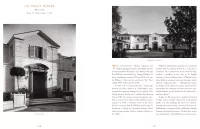
-

- David Decker
Houses of Los Angeles, 1920-1935
Houses of Los Angeles, 1920-1935 Published on Jun 7, 2012 Pages from the Houses of Los Angeles, 1920-1935 is the sequel to Houses of Los Angeles, 1885-1919. - Click pictures to read the section. This volume brings together for the first time house and garden plans with over 400 archival color and duotone photographs of downtown residences and mountainside estate houses, built by Hollywood celebrities and Los Angeles innovators including movie stars Mary Pickford and Douglas Fairbanks, Marion Davies and publisher William Randolph Hearst, radio innovator and Packard dealer Earle C. Anthony, Union Bank Chairman Ben R. Meyer and Native American art dealer Grace Nicholson
Houses of Los Angeles, 1920-1935
Houses of Los Angeles, 1920-1935 Published on Jun 7, 2012 Pages from the Houses of Los Angeles, 1920-1935 is the sequel to Houses of Los Angeles, 1885-1919. - Click pictures to read the section. This volume brings together for the first time house and garden plans with over 400 archival color and duotone photographs of downtown residences and mountainside estate houses, built by Hollywood celebrities and Los Angeles innovators including movie stars Mary Pickford and Douglas Fairbanks, Marion Davies and publisher William Randolph Hearst, radio innovator and Packard dealer Earle C. Anthony, Union Bank Chairman Ben R. Meyer and Native American art dealer Grace Nicholson
Houses of Los Angeles, 1920-1935
Houses of Los Angeles, 1920-1935Published on Jun 7, 2012
Pages from the Houses of Los Angeles, 1920-1935 is the sequel to Houses of Los Angeles, 1885-1919. - Click pictures to read the section.
This volume brings together for the first time house and garden plans with over 400 archival color and duotone photographs of downtown residences and mountainside estate houses, built by Hollywood celebrities and Los Angeles innovators including movie stars Mary Pickford and Douglas Fairbanks, Marion Davies and publisher William Randolph Hearst, radio innovator and Packard dealer Earle C. Anthony, Union Bank Chairman Ben R. Meyer and Native American art dealer Grace Nicholson
Posted Date
Sep 14, 2022
Historical Record Date
Jun 07, 2012
Source Name
Issuu
Delete Story
Are you sure you want to delete this story?
Jun 01, 1937
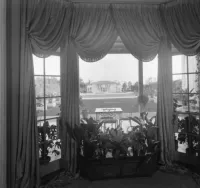
Paley mansion
Looking out from within the residence of Jacob "Jay" Paley, founder of the Columbia Broadcasting System (CBS), located at 1060 Brooklawn Drive in Holmby Hills.
Jun 01, 1937
Paley mansion
Looking out from within the residence of Jacob "Jay" Paley, founder of the Columbia Broadcasting System (CBS), located at 1060 Brooklawn Drive in Holmby Hills.Posted Date
Sep 14, 2022
Historical Record Date
Jun 01, 1937
Source Name
Tessa
Delete Story
Are you sure you want to delete this story?



